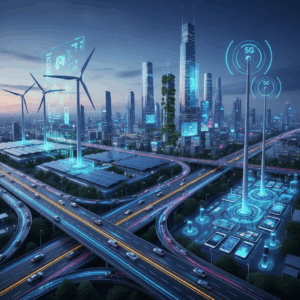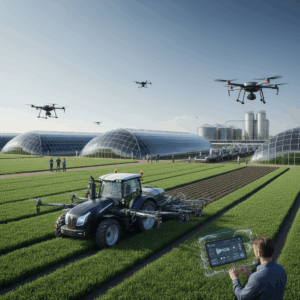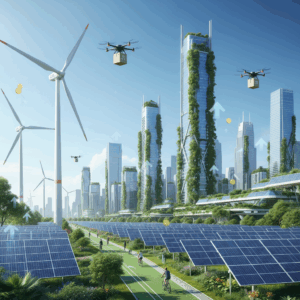Technological transformation in the economy
The Industry 4.0 It drives a radical change in the economy through automation and the intensive use of advanced technologies. These changes increase efficiency and productivity.
The business sector is adopting intelligent systems capable of operating autonomously, which optimizes processes and allows for large-scale customization. This is revolutionizing traditional production models.
Automation and smart factories
Automation is redefining factories, now equipped with sensors and robots that work together to improve production. This significantly reduces errors and downtime.
Smart factories enable efficient management and solve problems in real time, promoting optimal use of resources and more sustainable and flexible production.
Integration of AI and interconnected systems
Artificial intelligence connects systems through the Internet of Things, facilitating autonomous decision-making based on the analysis of large volumes of data.
These interconnected systems improve companies' adaptability to the market and promote innovation by anticipating demands and optimizing the production chain.
Labor impact of the 4.0 revolution
The Industry 4.0 It has a dual impact on the world of work: it creates both challenges and opportunities. Automation and AI are transforming the nature of employment.
It is crucial to understand how technology displaces certain jobs but also creates new professional areas, demanding constant adaptation of workers and skills.
job displacement effect
Many repetitive and administrative tasks are being replaced by machines and algorithms, leading to job losses in automatable sectors.
According to estimates, up to 491% of current jobs may disappear, especially in manufacturing and routine activities, generating uncertainty in the labor market.
This phenomenon forces a reconsideration of the distribution of work and income, affecting the stability and growth of certain traditional professions.
Job creation and new skills
Technology also creates jobs in areas linked to the digital economy, such as data analysis, AI programming, and maintenance of automated systems.
The demand for skills related to creativity, problem-solving, and technology management is increasing, promoting professional development and continuous training.
These jobs require advanced skills and foster innovation, changing the way people collaborate and produce within modern organizations.
Collaboration between humans and machines
In the new work reality, humans and machines work together, combining artificial intelligence with human creative and critical thinking skills.
This cooperation enhances the added value of tasks, where machines take over repetitive work and humans focus on strategic and creative activities.
Competitive advantage through technological collaboration
Companies that efficiently integrate this collaboration achieve greater productivity and adaptability, positioning themselves better in increasingly dynamic markets.
Economic and productive changes
Industry 4.0 is driving profound transformations in production and economic processes, accelerating digitalization and automation. These innovations are multiplying responsiveness and efficiency.
This environment allows companies to offer increasingly personalized products, adapting to the specific demands of consumers and improving competitiveness in globalized markets.
Improved productivity and personalization
Automation and real-time data analysis optimize resource use and reduce errors, significantly increasing productivity in production chains.
Furthermore, advanced manufacturing makes it possible to adapt products to individual needs, increasing customer satisfaction and fostering innovation in design and services.
This massive customization translates into greater added value and the generation of new opportunities for the industrial and commercial sectors.
Process optimization and decision making
Sophisticated analysis of large volumes of personal and production data allows for anticipating trends and quickly adjusting operations, optimizing costs and results.
Artificial intelligence facilitates automated and accurate decision-making, reducing uncertainty and improving strategic planning in organizations.
This comprehensive optimization transforms the way companies manage their resources and adapt to the competitive environment.
Social challenges and adaptations
The Fourth Industrial Revolution demands rapid social adaptation to respond to the labor and economic transformations brought about by technology. Educational systems must reinvent themselves.
Social security faces challenges in protecting workers in changing jobs and emerging economies, highlighting the need for inclusive and updated policies.
Training and social security
Continuous training is crucial to maintaining employability in a labor market that values new technological skills and the ability to constantly adapt.
Social security systems must evolve towards more flexible models that cover both traditional jobs and new digital and self-employed jobs mediated by technology.
Investing in technological education and professional retraining programs reduces the gap between market demand and workforce skills.
Labor market structure and flexibility
The labor market is becoming more dynamic and flexible, with the emergence of modalities such as teleworking, temporary jobs and digital platforms, requiring adequate regulation.
The balance between flexibility and labor protection is fundamental to avoid precariousness and guarantee rights, promoting safe and sustainable working environments.
Societies will need to adjust their legal framework and labor policies to support this transition and take advantage of the opportunities of an automated and interconnected economy.






